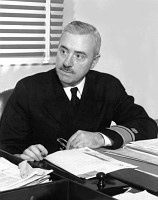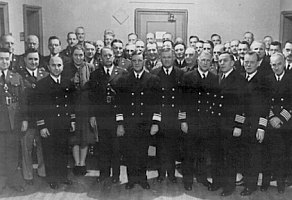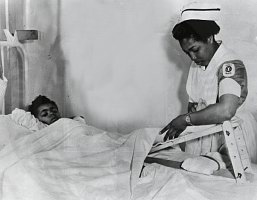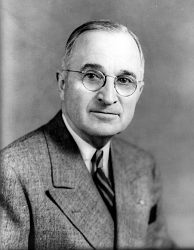Public Health Service in
World War II
.
In 1939, President Franklin D. Roosevelt put
the Public Health Service under his newly created Federal Security Agency
by Reorganization Plan No. 1 of 1939, effective July 1, 1939. The Federal
Security Agency was established to promote social and economic security,
educational opportunity, and the health of the citizens of the Nation.
The Public Health Service prepared for war
when America mobilized during 1940. |
... |

President Franklin D. Roosevelt
|
.
In November 1941, the Coast Guard was militarized
and PHS officers served as its medical branch. The Coast Guard was a major
duty, and nearly 700 PHS officers served in it on combat duty throughout
World War II, including nurses starting in 1944.
.
 |
.. |
Medical Officers of the Public
Health Service have been assigned to Coast Guard vessels since 1879. Early
assignments were for example expeditions to Alaska, the Arctic, and on
training cruises from the Coast Guard Academy.
The picture shows officers aboard
the Coast Guard Cutter Bear which served in the Arcticon for 40 years on
various rescue, assistance, investigation, and patrol missions (c. 1915). |
.
In December 1941, when America declared war,
many PHS officers were immediately detailed to the Army and Navy. All Public
Health Service programs experienced tremendous growth and the number of
personnel increased from 8,000 in 1940 to over 16,000 by 1945. The Commissioned
Corps of the Public Health Service employed top-rate doctors, highly trained
scientific personnel and nurses of the finest quality.
.
| The Service was consolidated during 1943 to
comprise four main components -- the Office of the Surgeon General, the
National Institute of Health, and the new Bureau of Medical Services and
Bureau of State Services.
The 1944 Public Health Service Act further
strengthened the medical and administrative authority of the Service and
its Surgeon General. |
.. |

Surgeon General Thomas Parran
|
.
The PHS was active in most health areas during
the war. The Service insured adequate public health services and strengthened
medical assistance to the states. Malaria control around military camps
and maneuver training sites was supervised by the Malaria Control in War
Areas program. Disease prevention and fighting yellow fever, dengue,
and typhus continued. Late in the war, the PHS established an Office of
International Health Relations to handle increasing overseas health concerns.
Medical services were provided to the United Nations Relief and Rehabilitation
Administration within refugee camps in Europe and Near East.
.
 |
.v |
PHS Sanitary Engineers dealed
with problems related to water supplies, sewage disposal, industrial wastes,
and other environmental hygiene concerns. With their work they helped to
control yellow fever, malaria, and waterborne diseases, such as typhoid
fever.
The picture shows PHS Sanitary
Engineers during WWII. |
.
The Service supported research into many aspects
of health care on the home front.
.For
instance, it investigated hazardous substances to protect war factory workers.
The Service examined new explosives, developed methods to determine the
amount of lead or TNT in urine (so that workers could be tested for overexposure),
and demonstrated the affinity of lead for bone tissue.
.
Other investigators determined that the vapors
of methyl, ethyl, isopropyl, and butyl alcohol were acutely toxic to workers.
This work improved conditions of employment for more than 300,000 workers
in wartime industries. |
.vv |
 A fumigating and disinfecting
team getting ready to work in New Orleans.
A fumigating and disinfecting
team getting ready to work in New Orleans.
1939
|
.
 Researcher Emily Emmart
working in the National Institute of Health's Rocky Mountain Laboratory
in Hamilton, Montana (c. 1937).
Researcher Emily Emmart
working in the National Institute of Health's Rocky Mountain Laboratory
in Hamilton, Montana (c. 1937).
|
.v |
Treatment of tropical diseases was undertaken
at the PHS Rocky Mountain Laboratory in Hamilton, Montana, where yellow
fever and typhus vaccines were prepared for military forces.
.
In Bethesda, Maryland, a synthetic substitute
for quinine was sought to treat malaria. Sampling techniques were developed
to avoid bacterial contamination in plasma and blood.
.
The PHS revealed that sodium deficiency was
a direct cause of death after burns or traumatic shock, leading to the
widespread use of oral saline therapy as a first-aid measure on the battlefield. |
.
PHS military physiologists researched problems
of high altitude flying. They determined the altitude at which oxygen needed
to be given, in order to prevent pilots from blacking out, and designed
an apparatus to supply the extra oxygen efficiently.
.
They also studied the relation of pressure
changes to bubble formation in liquids to address the problem of emboli
forming in the blood of pilots.
.
Other tests were made to evaluate the efficiency
of flight clothing, especially electrically heated suits, and to determine
the effect of altitude on visual ability, and devices to improve night
vision. |
.v |

WWII Oxygen/Communication Mask,
Courtesy of Dr. Adrienne Noe, Director, National Museum of Health and Medicine |
.
 A Black Cadet Nurse working
A Black Cadet Nurse working
at Freedmen's Hospital.
|
.v |
The severe wartime shortage of nurses resulted
in a uniformed Cadet Nurse Corps as part of the Public Health Service under
the Nurse Training Act of 1943.
Participants received scholarships and monthly
payments to attend nursing schools by agreeing to work in essential nurse
positions after graduation for the duration of the war.
The entire program graduated 124,000 nurses,
of which over 3,000 were Black and other minorities who became valuable
health professionals. |
.
Military Status
The Public Health Service performed active
wartime service during 1898 by supporting military forces during the Spanish-American
War. Both Army and Navy were treated in the PHS marine hospitals. Yellow
fever was confronted by PHS officers sent on emergency duty to front-line
positions in Cuba and Puerto Rico. The PHS Commissioned Corps accompanied
troop transports, staffed temporary quarantine stations, and saw combat
within the fleet at the Battle of Manila Bay in the Philippine Islands.
.
President Wilson invoked the Act of July 1,
1902, to militarize the Public Health Service by executive order on April
3, 1917.
Using the PHS as part of the armed forces
was confirmed by a Congressional resolution of July 9, 1917.
However, this militarization of the PHS was
later repealed by the US Attorney General on October 29, 1921. He ruled
that only Congress could create a military force from a civilian agency.
The Public Health Service could be utilized alongside the armed forces,
but could not be transformed into "military or naval forces of the United
States." |
.v |

Thomas Woodrow Wilson, President
of the United States from March 4, 1913 – March 4, 1921
|
.

Female PHS member wearing the
outdoor uniform of the comissioned corps.
|
.v |
This legal entanglement was avoided during
World War II, because President Roosevelt was given direct Congressional
authority for militarizing the PHS. This vital legislation, which became
effective November 11, 1943, also gave full military benefits to all PHS
commissioned officers.
For the first time the Commissioned Corps
could serve in a full military capacity in wartime. The Public Health Service
Act of July 1, 1944, reinforced the militarization of the PHS Corps under
President Roosevelt.
However, a few problems remained. The Commissioned
Corps of the Public Health Service had existed for a half-century prior
to World War II and expanded in 1944 to include female scientific personnel
and nurses. There was a practical need to designate the PHS as a military
force in all regards.
For example, some nurses were detailed to
secret organizations like the Office of Strategic Services (OSS), which
later became the CIA. |
.
| This required confirmation of full PHS military
capacity to serve in combat, regardless of mission scope or secrecy. Therefore,
on June 21, 1945, President Truman signed Executive order No. 9575 that
declared "the Commissioned Corps of the Public Health Service to be a military
service and a branch of the land and naval forces of the United States
during the period of the present war."
In other words, Executive Order 9575 declared
the Commissioned Corps of the Public Health Service to be a military service
in every respect, and prescribed appropriate regulations (Federal Register
page and date: FR 10 7895, June 29, 1945). |
... |
 Harry S. Truman, President
of the United States from April 12, 1945 – January 20, 1953.
Harry S. Truman, President
of the United States from April 12, 1945 – January 20, 1953.
|
.
.
[ I. Development ]..[
II. Facts about the PHS ]..[
III. PHS Uniforms ]..[
IV. Sources ]
|
